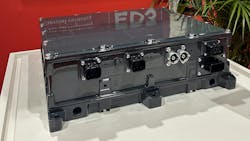Danfoss Optimistic About the Future of Hydraulics
Hydraulics remain an important part of Danfoss Power Solutions’ business and a technology in which the company is continuing to focus new development efforts.
Despite the growth taking place in the electrification space, Eric Alström, President of Danfoss Power Solutions, does not see a point at which hydraulics will completely disappear due in part to the power density they provide.
But this does not mean there are not opportunities for improvement. Increasing the efficiency and connectivity of hydraulic systems are two of the major areas in which technological developments can be made — and areas where Danfoss itself is focusing.
In this second part of a two-part interview series on the state of the hydraulics industry, Alström discusses with Power & Motion why Danfoss continues to be optimistic about hydraulic technologies and their ability to meet ever-evolving market trends.
Editor’s Note: Questions and responses have been edited for clarity. Read “Danfoss Sees Growth Opportunities Despite Down Cycle” for the first part of this interview series with Alström in which he discusses current market conditions and opportunity areas for hydraulics.
P&M: Danfoss is continuing to invest in hydraulic solutions of various types, so I presume the company continues to see a long life for this technology?
EA: Absolutely. Still, in most cases, power and energy density speak in favor of hydraulic technologies. I don't think there's going to be a tipping point where it's going all electric. And in fact, we're seeing a lot of hybrid machinery, where it makes sense such as forestry machinery that are hybrid-electric diesels and so forth. There is an element of pure electric machinery that makes sense too, usually smaller, but packaging of electric motors and carrying batteries as an energy source is difficult still for most of the applications we serve.
This will take a while before we see any meaningful trend change. It's picked up faster than we thought, the electrification side, and it's our fastest growing business. But I also think we're coming to a point where most of those early, easy applications are sort of done, and now we come to the more difficult ones, so it will plateau a little bit. We're helped by the fact that we're also in the on-highway space with Editron. There we are very successful, for instance, with our onboard charger, [and] also with our rugged motors and our inverter platform.
I'm pretty optimistic; we're well positioned to benefit from any trend change, because we're trying to listen carefully to what our customers say, and reading how the general public also is reacting to different types of technologies, and not the least, of course, our end users. And we do in fact test a lot of our machines with end users to get their feedback also. So not only with our OEM and distribution partners, but also with their end users; we are in discussions and test machines together.
P&M: Is Danfoss finding that people are embracing the electric technology more than they might have in the past?
EA: I think so. And still hydraulics are absolutely core to Danfoss, we are still super bullish [on them]. We have a lot more we can do in hydraulics, a lot more product improvement we can do to be even more energy efficient going forward. But clearly, with our Editron technologies it’s absolutely the right thing to have in our portfolio. And you’re right, there’s a very strong interest even from smaller machine builders that maybe want to differentiate themselves from larger OEMs. And there we are well positioned with our partner network, because we can become an extended engineering workbench for many of those OEMs.
P&M: Besides electrification, are there other industry trends or technologies that could be coming to hydraulics or will influence their development in the coming years?
EA: I think so. It's similar to the combustion engine, where everybody said in the early 90s that they can't get much better than they are but if you see what the fuel efficiency of a combustion engine is today versus then, it's a little bit the same in hydraulics. The new generations of valves and pumps that we launched are significantly more efficient than the previous generation and also more productive.
Our technologies help machinery become more productive [because when] you use less fuel, you work more productively. I think that productivity trend is another one that a lot of customers pay attention to, although in the past, I think maybe that was more focused from end users than efficiency, today it's more balanced. It's a similar value for both. If you can offer higher productivity and better fuel efficiency, which we do through systems that we engineer for many of our customers, that is a very compelling value proposition.
P&M: Are you seeing much impact from digitalization of hydraulics technologies, and how might that trend continue?
EA: It's really a clear benefit to be able to offer the connectivity inside of an entire machine, everything from the software, which we have on the controllers, to controlling each individual part of the hydraulic system through digital means. Software is incredibly important for us today, and that's another way for us to differentiate and bring more value to our customers. The whole aspect of connectivity is in hydraulics, I think today; it's not just a benefit, but it's a necessity. If you want to have a productive and fuel-efficient machine that end users will appreciate, digital controls are absolutely critical.
It's that aspect of also having a whole systems approach because it’s one thing sourcing a controller, loading your software then sourcing different components. But if you can get all that tailored from one source, many of the OEMs really value that because that’s a much easier way of optimizing the system rather than them trying to do that with individual components from different sources.
READ MORE: Understanding Digitalization and its Use in Fluid Power
P&M: That seems to be the way the industry has been trending for a while but also appears to have picked up steam.
EA: I agree. I think there’s been sort of a tempo change in terms of the interest in solutions rather than components. And I think, frankly, one of the reasons for that is also a challenge we’re all dealing with in the hydraulics industry — it’s hard for the OEMs to find engineers that can do hydraulics. It’s difficult for us too. I call it the Danfoss box that we need to open and show young engineers that we have cool stuff here. It's software, connectivity, joysticks, displays, digitally controlled pumps and valves — when they see that they actually think it’s pretty cool and want to work for us. But we have to get them to look inside the box first and that’s the challenge.
Before you come to this industry or start working with hydraulics, you never think about it because it’s there and it’s super important in everything we do everywhere, but you just don’t see it. It is neat in many ways but it’s a challenge when it comes to recruiting great engineers.
P&M: In a perfect world, what could the industry do to help recruit more people?
EA: We’re fortunate enough to be in great places close to great universities like in Ames we’re close to Iowa State University and we have a great collaboration with that university where we help with labs and so on. So, we get students that are interested in our technologies. We do the same in China and Europe, and that is helping.
And there’s an initiative from players in the industry…to collaborate when it comes to making universities more enthusiastic about teaching hydraulics curriculum and perhaps being more focused rather than all universities trying to teach everything. It would be nice if some were more specialized. We are having great success together with our competitors in doing so. I applaud my colleague from a different company who thought this through and started it, and we’re fully supportive of this because it’s a great idea for all of us. We’ve got to get into the universities early so that when students are doing projects…they are in a lab where they see the technologies that we use and why it’s important. And, by the way, it is contributing to a healthier, greener world by means of being more efficient than in the past. When they see and hear that, I think it’s easier to rally the interest.
P&M: What technology or trend most excites you and are you most looking forward to in the coming years?
EA: I’m pretty excited about everything we’re doing at the moment. We’ve never had more new products and new technologies being launched as we do right now. Even in a year like this, as a company we’re spending 7% of revenue on R&D and will continue to do that because that’s Danfoss’ culture, we’re committed to driving new technology to new heights and making the world a better place. That’s deeply rooted in us being a family-owned company. We don’t think in quarters, we think in generations. And that sets us apart a little sometimes, I think in a good way. So it’s hard for me to single out a particular technology, I’m really excited about everything we do.
But if you force me to pick something, I think the industrial division and the fluid conveyance division, the previous owner of those businesses didn’t invest perhaps as much as what was necessary to make those businesses thrive and now, we are doing that and they are thriving. I’m absolutely convinced that we will become significantly bigger in a very short period by means of investing both in manufacturing equipment, upgrading our factories, and on the technology side.
I’ve asked the same question of our partners, and they say the same thing, “I can’t really pick one,” but I think a common denominator is also sustainability. It’s at different levels in different parts of the worlds but it will become a common denominator. All of our OEM customers are asking us about our sustainability agenda, they’re very serious about it and we are serious about it as a company. Our headquarters in Denmark where we have several factories in the same area is CO2 (carbon dioxide) neutral today as of last year. That’s just one step on the way; that’s our ambition, all our locations will be CO2 neutral going forward and that’s a strong commitment on our side. And it’s also helping us to recruit people because a lot of young people are very conscious about green technologies and being part of a company taking [sustainability] to heart.
READ MORE: How is Sustainability Impacting the Fluid Power Industry?
I’m very optimistic about our future. It’s not so fun to be in a down cycle because of all the changes we had to make but I’m very optimistic, very bullish about the future of Danfoss Power Solutions and hydraulics.
About the Author
Sara Jensen
Executive Editor, Power & Motion
Sara Jensen is executive editor of Power & Motion, directing expanded coverage into the modern fluid power space, as well as mechatronic and smart technologies. She has over 15 years of publishing experience. Prior to Power & Motion she spent 11 years with a trade publication for engineers of heavy-duty equipment, the last 3 of which were as the editor and brand lead. Over the course of her time in the B2B industry, Sara has gained an extensive knowledge of various heavy-duty equipment industries — including construction, agriculture, mining and on-road trucks —along with the systems and market trends which impact them such as fluid power and electronic motion control technologies.
You can follow Sara and Power & Motion via the following social media handles:
X (formerly Twitter): @TechnlgyEditor and @PowerMotionTech
LinkedIn: @SaraJensen and @Power&Motion
Facebook: @PowerMotionTech

Leaders relevant to this article:





